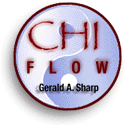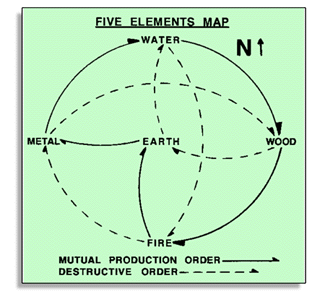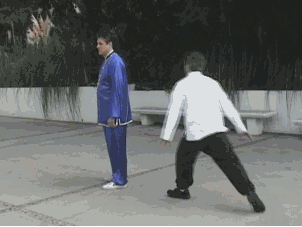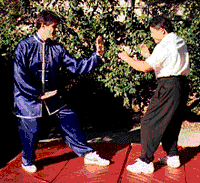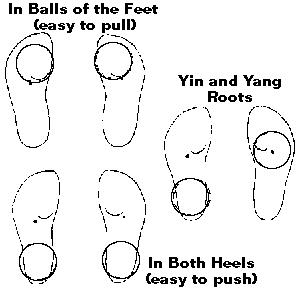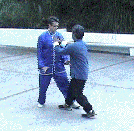(Xingyiquan and Hsing I Ch'uan are different English translation schemes for the same "Form and Will Fist" martial art.) Also see:
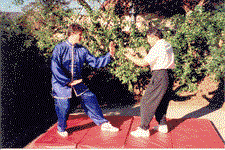
An Overview of Hsing I Chuan (Xingyiquan) - page 1
by Gerald A. Sharp
Animated picture: Xingyiquan Dragon Application (Take Down) Jiang Rong Qiao system. More applications appear as links later in this page and in other pages on the chiflow.com website.
The Development of Hsing I Ch'uan (Xingyiquan)
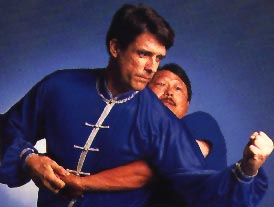 Hsing-I was developed by Ji Long Feng who was a martial artist known for his ability with a spear who lived near the end of the Ming dynasty and the beginning of the Qing dynasty. His love of the spear was so great that he set about to develop a system that would incorporate the theories of spear tactics in hand to hand practice.
Hsing-I was developed by Ji Long Feng who was a martial artist known for his ability with a spear who lived near the end of the Ming dynasty and the beginning of the Qing dynasty. His love of the spear was so great that he set about to develop a system that would incorporate the theories of spear tactics in hand to hand practice.
During his quest, he met a hermit monk living in seclusion on Zhong Nan mountain who taught Ji Long Feng a martial art known as Yueh Fei Chuan Pu. A martial art believed to be created or popularized by the folk hero Yueh Fei, a general in the Emperor's army during the Song dynasty.
 Yueh Fei was a hero who honorably served the emperor. However, a treacherous court official named Ching Gui, spoke to the Emperor terribly about Yueh Fei. Trumping up fabricated charges of treason, Yueh Fei and his entire family were executed by Imperial order. To this day people are said to spit on Ching Gui's grave, while paying tribute and honor at Yueh Fei's.
Yueh Fei was a hero who honorably served the emperor. However, a treacherous court official named Ching Gui, spoke to the Emperor terribly about Yueh Fei. Trumping up fabricated charges of treason, Yueh Fei and his entire family were executed by Imperial order. To this day people are said to spit on Ching Gui's grave, while paying tribute and honor at Yueh Fei's.
After a great deal of arduous training and deep contemplation, Ji Long Feng suddenly saw an important concept in a clear light. He discovered how to naturally connect his internal power (Nei Kung) with the outer shape of his body (Wai Hsing).
We offer some hard to find books and videos on Xingyiquan. Jiang Rong Qiao's "Xingyiquan Motherfist" translated by Joe Crandall has been matched with a two-volume instructional video series featuring Gerald A. Sharp. Additionally, we offer an Yi Quan instructional video series and a number of Xingyiquan form demonstrations videos that are only offered here.
|
1. The Five Elements Ji Long Feng further related his movements to the traditional theory of the Five Elements as follows:
These Five Elements have two basic cycles:
|
2. Constructive and Destructive Cycles Just as the inner power (Nei Kung) and the outer shape (Wai Hsing) needed to be connected, according to Ji Long Feng, so must the two cycles of the Five Elements. In fact, most Hsing-I-Chuan styles place the training of the Five Elements and their martial applications at the very root of their art. This is the path for Hsing I Chuan practitioners to achieve a deeper understanding of the two grand opposites of Yin and Yang. They learn how to harmonize and utilize the attributes of both cycles of the Five Elements, thereby achieving balance, structure, and sophistication.
In this theory, the destructive cycle can be used to intercept and capture the intended outcome and physical shape of any action that is correctly parsed into the Five Elements categories. This theoretical foundation provides a framework for quickly understanding a situation and what needs to be done. The picture of constructive and destructive cycles initially may seem restrictive (and perhaps simple), but the implementation is open and it is actually a set of building blocks for effective action and innovation. |
|
3. The Five Elements and Martial Applications One quickly gets to tactical applications of the Five Elements as an intuitive understanding of body dynamics is trained in Hsing I Ch'uan forms and practice methods. An investigation of the destructive cycle's effect on the mutual production can lead to a deeper understanding of the five elements and their use in self defense:
However, it should be pointed out that the fists themselves are not only methods of punching, but methods of intercepting energy and utilizing more internal methods of warding off, grappling, and throwing more often associated with effective internal martial arts. |
4. The Next Level In this Hebei style of Hsing ICh'uan, the Five Elements are taught through the Five Fists form sequence. One then learns the linking form to integrate them. Push Hands in Hsing I Ch'uan is also taught using the Five Elements. The 12 Animals forms come next. The Twelve Animals of Hsing-I Chuan are a combination of aspects of the Five Fists synthesized with the behavior of animals. For example, the Snake of Hsing-I (above image sequence) combines Drilling (Water), Crossing (Earth), and Splitting (Metal) with movements that are slithery yet graceful, dragging yet rushing, pulling yet explosive. |
|
5. Finding Balance and Knowing What is Out of Balance With an understanding of the productive and destructive order of the elements, it is easier to understand how these two cycles can be used complimentary in creating or destroying balance. Traditionally, this concept is presented in terms of the Grand Terminus: Yin and Yang is not merely divided in half with a straight line. Instead, Yin and Yang are divided by a curved line that is the combination of oppositional forces associated with the order of creation and the with the order of destruction.
|
6. The Five Elements and Emotions The five elements and their attributes can be applied in everyday life when dealing with excessive emotions. According to the Five Elements, emotions lead into one another as follows: Excessive sorrow (Metal) leads to fear (Water), excessive fear (Water) leads to anger (Wood), excessive anger (Wood) leads ultimately to joy (Fire), excessive Joy (Fire) leads to Over Thinking (Earth), and so on. To counteract excessive emotions, which drain the body's vital energy, first seek to be calm. Then use the destructive order to control and do away with that which is draining. For instance, overly sad (Metal), draws heavily on the lung's energy. Counteract sadness with joy (Fire) and be free of sadness. Harmonizing these two approaches is easier said (or even thought about) than done. However, with an internal art system such as Hsing-I Chuan, mythology meets reality and the mind, body, and spirit have a gateway and a path to make Yin and Yang more than a just a mere thought but an exact, precise actualization rooted in timeless wisdom. Once one has acquired the ability to apply the Five Phases scheme of Hsing I Ch'uan, the simple and direct approach becomes sophisticated and minimalist. It can be applied in many areas of life. |
|
7. Mixing the Art From a martial arts perspective, Hsing I Ch'uan has an open implementation within the well-defined groupings of the Five Elements. On the one hand, this is why it is relatively easy for the martial arts of Hsing I Chuan and Pa Kua Chang to exchange ideas. On the other hand, Hsing I Chuan achieves minimalism through the Five Elements grouping and this clear set of groupings has to be maintained even within the Twelve Animals forms, Push Hands or other practice. |
8. Much More About Hsing I Chuan (Xingyiquan) The Hebei style of Hsing-I Ch'uan is organized using 12 Animals that group and teach the martial characteristics of particular actions. On a more fundamental level, Hsing I is built on "Five Elements" (or "Five Phases") that provide a system for categorizing and understanding the relationships between types of actions. See other pages on this website: |

